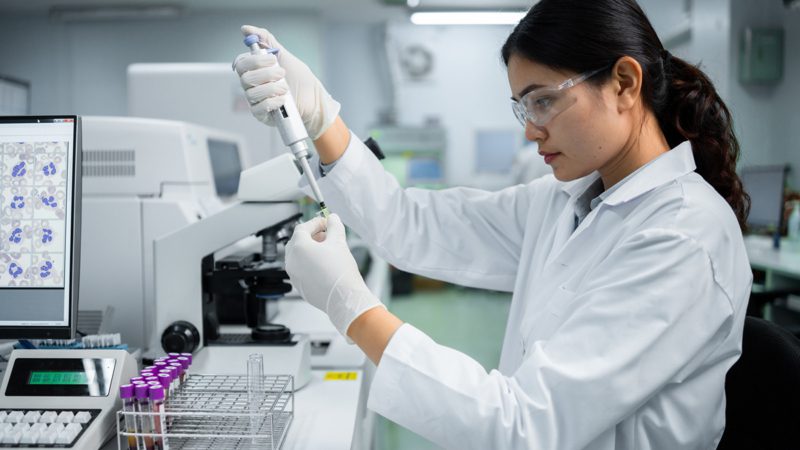Various PFAS and phenols were linked with higher rates of previous melanoma, ovarian cancer and uterine cancer diagnoses, according to a new study co-led by the Keck School of Medicine of USC.
By Zara Abrams
In a large-scale analysis of chemical exposure and hormone-related cancers, researchers based at the Keck School of Medicine of USC, the University of California, San Francisco (UCSF) and the University of Michigan found new associations that can inform future research and regulations relating to environmental health.
The research team, funded in part by the National Institute of Environmental Health Sciences, studied a sample of more than 10,000 adults who participated in the National Health and Nutrition Examination Survey (NHANES) between 2005 and 2018. Women with a previous diagnosis of melanoma, ovarian cancer or uterine cancer had higher concentrations of per- and polyfluoroalkyl substances (PFAS) and phenols in their blood. The results were just published in the Journal of Exposure Science and Environmental Epidemiology.
“These findings show that PFAS and phenols are potential environmental risk factors for cancer risk in women,” said Max Aung, PhD, the study’s senior author and an assistant professor of population and public health sciences at the Keck School of Medicine. “Our study can be used to help prioritize which chemicals to investigate and mitigate exposure to as we continue working to reduce cancer risk.”
PFAS, sometimes called “forever chemicals” because they break down very slowly, are used in products such as nonstick pans, cosmetics and waterproof clothing. Phenols include BPA, which is commonly used in food packaging, water bottles and toys, as well as other substances used in products such as air fresheners and synthetic dyes. These manmade chemicals have contaminated water, soil, food and people around the world.
“These PFAS and phenol chemicals appear to disrupt hormone function in women, which is one potential mechanism that increases the odds of hormone-related cancers in women,” said Amber Cathey, PhD, MPH, first author of the study and an assistant research scientist at the University of Michigan School of Public Health, though this mechanism was not a focus of the present study.
Linking chemical exposure to cancer
To study the link between chemical exposure and hormone-related cancers, the researchers analyzed data from NHANES on self-reported previous diagnoses of melanoma and cancers of the thyroid, breast, ovary, uterus and prostate in adults, ages 20 and older. They compared those findings to data on concentrations of PFAS, phenols and parabens from patients’ blood and urine samples. Chemical measurements were done after cancer diagnoses, so the data show only an association, rather than a causal link, between exposure and cancer.
Women who had a previous melanoma diagnosis were more likely to have higher levels of several types of PFAS, including perfluorodecanoic acid (PFDE), perfluorononanoic acid (PFNA), perfluoroundecanoic acid (PFUA) and benzophenone-3 (BP3), as well as several types of phenols, including 2,5-dichlorophenol (DCP25) and 2,4-dichlorophenol (DCP24). Women who had a prior ovarian cancer diagnosis were more likely to have higher levels of DCP25, bisphenol-A (BPA) and BP3. And women with a prior uterine cancer diagnosis were more likely to have higher levels of PFNA.
The researchers also identified different risks based on racial/ethnic background. In particular, Mexican American and other Hispanic women had higher odds of a previous diagnosis of breast or uterine cancer linked with select chemical exposures.
“Future studies should build on this work to explore intersecting social identities, such as immigrant status, educational attainment and neighborhood factors, to better understand how to identify high-risk groups to strengthen prevention and intervention efforts,” said Aung.
Next steps for researchers and regulators
“As communities around the country grapple with PFAS contamination, policymakers should account for the results of this study as they develop a plan of action to reduce PFAS exposure,” said Tracey J. Woodruff, PhD, MPH, UCSF professor and director of the Program on Reproductive Health and the Environment and director of the UCSF EaRTH Center, which supported the study.
“Since PFAS make up thousands of chemicals, one way to reduce exposures is for EPA to regulate PFAS as a class of chemicals, rather than one at a time,” Woodruff said.
In addition to providing information for regulators, the researchers say these findings can guide more in-depth research on specific chemical exposures and cancer. At the Keck School of Medicine, the Southern California Environmental Health Sciences Center and the Norris Comprehensive Cancer Center have formed a partnership through which they will co-fund pilot projects focused on environmental health risks.
About this study
In addition to Aung, Cathey and Woodruff, the study’s other authors are Vy Nguyen of the University of Michigan School of Public Health and Harvard Medical School; Justin Colacino of the University of Michigan School of Public Health; and Peggy Reynolds of the Department of Epidemiology and Biostatistics, University of California, San Francisco.
This study was funded by the UCSF EaRTH Center [P30-ES030284] and the Helen Diller Family Comprehensive Cancer Center [5P30CA082103-23].
Additional support was provided in part through the National Institute of Environmental Health Sciences [P30-ES00748, P30ES017885, R01ES028802]; the National Cancer Institute/National Institute of Environmental Health Sciences [1UG3CA265845-01, UG3CA267907]; and the Harvard Data Science Initiative.
